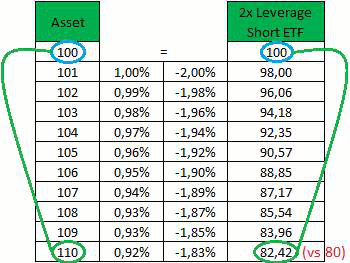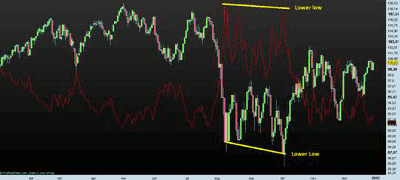Research has shown that leveraged ETF products may not perform nearly as expected in these volatile markets, a quality that proves them as being suited only for very short-term trading.
ProShares states on its Web site:
“Each Short or Ultra ProShares ETF seeks a return that is either 3x, 2x, -1x, -2x or -3x of the return of an index or other benchmark (target) for a single day, as measured from one NAV calculation to the next. Due to the compounding of daily returns, ProShares’ returns over periods other than one day will likely differ in amount and possibly direction from the target return for the same period.
These effects may be more pronounced in funds with larger or inverse multiples and in funds with volatile benchmarks. Investors should monitor their ProShares holdings consistent with their strategies, as frequently as daily.”
While I sometimes use those products for short-term trades, I will never hold them for a long time.
Let me explain why.
Imagine you have an asset class with a price today of $100. To keep it simple, let’s also assume that the 2x long ETF also trades at $100 today.
From the table below, you can see that if the asset is going in one direction without a lot of volatility, you may actually gain more on the leveraged ETF than initially expected. While the asset class rose from $100 to $110 (+10%), the leveraged long ETF gained +20.89%, although we expected it to be +20% (two times the percentage gain of the asset class).
This is a favorable situation.

However, imagine we get a situation that works against us. We own a 2x short ETF, and the market keeps rising.
In this case, we are lucky as well, because we will "only" lose ($100-$82.42)/$100=17.58%, while we would expect a loss of -20%.

The two tables above show us that we might get a favorable situation with leveraged ETFs when volatility is very low.
NEXT: Volatile Conditions Cause Big Problems
|pagebreak|But what happens when volatility is very high, as it has been recently?
Let’s assume again we have an asset class which is priced at $100, and a leveraged short ETF which is also priced at $100 today.
If the volatility is very high, we might end up losing a lot of money, as we can see from the table below. Even though the asset class ended up just where it began (at $100), our 2x short ETF has lost 7.94%!
The same would be true if we have a 2x long ETF: even though the asset class ended up just where it began (at $100), we would have lost money with the leveraged long ETF.

NEXT: Real Market Example That Cost Traders Dearly
|pagebreak|To give you an example, let’s have a look at the silver price, the ProShares Ultra Silver ETF (AGQ), and the ProShares Ultrashort Silver ETF (ZSL).
In the chart below, I set the initial value of each at $100, starting at January 1, 2011. The candlestick chart is the silver price, the green line is AGQ, and the purple line is ZSL.
As we can see, silver lost 12.25% this past year, so one would expect to have gained two times 12.25%, or 25.50%, with ZSL this past year then, right?
Wrong! ZSL lost 59.75% in the past year!
See related: Leveraged ETFs: Worst Investment Ever
In addition, one would expect to have lost two times 12.25%, or -25.50%, with AGQ this past year, right?
Wrong again! AGQ lost 46.79% this past year!
It can also happen with the -1x ETFs, even though they do not leverage the price.
Let’s have a look at the S&P 500 (SPX) versus the ProShares Short S&P 500 (SH) since January 1, 2011.
While the S&P 500 gained 0.43% since the beginning of the year, SH lost 8.21%!
The correlation may be high, but it’s not perfect.
That’s why you have to mind the leveraged ETF products. They can be used for very short-term trades (usually only a day or two), but don’t buy them to buy and hold unless you expect price to keep going in one direction. Even then, these variations may occur.
See related: The Leveraged ETF Safety Kit
The bottom line: stick to short-term trades in any leveraged ETF!
By Willem Weytjens of Profitimes.com
























